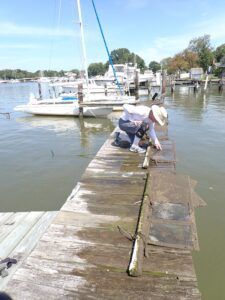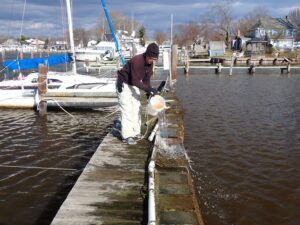We consider two years to be the practical limit for antifouling paints, and we like to haul our boats every two years for other inspections anyway. But we had the panels in the water, so we extended the observation period to three years. Surely, there are sailors in low fouling areas where a 36-month schedule makes good sense. Less painting is good for the pocketbook and good for the environment too.
This anti-fouling paint test took place in the mid-Chesapeake Bay In Deale, MD. This is brackish water, not seawater, with salinity in the test area swinging from 14% to 30% that of seawater (measured) and averaging about 23%. The nearby sailing waters range from 20-40% of ocean salinity. Salinity is highest in the fall and lowest in the spring. Low salinity, particularly below 15%, can cause both soft and some hard growth to fall away, as can freezing winter temperatures.
On the regulatory side, we’ve heard nothing new from California, Washington, or the EPA about regulation of anti-fouling paints. Most likely the big paint reformulation rush is over, and those we have tested will be around for a good while.
TEST PANELS AFTER 36 MONTHS
The panels were suspended from floats just below the water surface, extending from about 6 inches to about 24 inches down. They were exposed to sunlight for about half of each day during the test period.

We checked on the panels quarterly and formally inspected them at 12 months, 24 months, and 36 months. Before inspection, the panels were laid on the dock, sluiced off with a 2-gallon bucket four times in each direction to remove loose material that would be quickly flush off underway, and graded on a relative scale, with virtually clean and no hard growth receiving a 1, and numerous barnacles or remarkably heavy soft growth equivalent to no anti-fouling receiving a 5. This time we used our DIY canvas bucket to do the sluicing, which reduced the effort at least 50% vs. a plastic 3-gallon plastic bucket. (See “The Best Boat Bucket You Can Buy,” April 2023.) See panel rating table for paint details, and 12-month, 24-month, and 36-month ratings.
Ablative Paints. Of the solvent based ablatives, only Pettit Odyssey 60 still rated 2 on our scale, which means just a few barnacles and minimal soft growth. Our old-formula West Marine PCA Gold panel also rated 2, but it is out of production. We did not test the new PCA Gold, since it was not available at the start of the test, but we were told by Pettit reps (PCA Gold is a private label of Pettit) that it is very closely related to Odyssey HD, which although good for the first 24 months, dropped to a 3 rating after 36 months.

Hard Paints. Trinidad 75, Trinidad Pro, and Trinidad HD all rated 2. But the clear winner, was International Ultra-Kote, which was the only panel to earn a rating of 1 after 36 months in the Chesapeake Bay. It was amazingly clean, as though it had only been in the water a month.
Copper-Free Paints. Total Boat Krypton rated 1 or 2 through most of the test period, and hung on to rate 2 after 36 months. It was also the only copper-free paint to rate better than 4.
Water-Borne Paints. The water clean-up feature means little to us, because you can’t legally clean the brushes in the sink (these are all high copper paints) and you will be wearing disposable gloves and clothing anyway. Yes, you save a few pounds of VOCs. As for breathing the fumes, they are minimal if you stay up wind and use a roller extension, and you can wear a respirator. The days of benzene and carcinogenic solvents are long past.

10. rinsing panels They looked a lot better at 12 months
Finally, water-borne does not always mean low copper; the effective paints were as high in metals as solvent-borne paints. That said, Interlux Micron Aqua turned in solid performance, rating 2 after 36 months. Water-borne paints have come a long way. At least this one.
TESTING PAINT ON THE BOAT HULL
After the success of copper-free Krypton in our 24-month test, both on panels and on the test boat, we painted the entire boat (F-24 trimaran), including the center hull, both amas, and the centerboard, with two coats of Total Boat Krypton. After 12 months on the boat, only the thinnest film of slime has attached, easily wiped off with your hand. There were only four barnacles total, including all three hulls. We did not bother to clean it, knowing that a fast sail will knock most of it off, and freezing weather will be here in a few months.
General observations. Adult barnacles can damage any paint, even the best hard paints. When scraped off they either leave a glue circle where another barnacle will soon attach, or the paint itself is damaged. Same result. And even though hard paints can withstand light scrubbing, if you use something aggressive, like a red Scotch-Brite pad or a stiff brush, they will wear away. Remove the barnacles while they are still babies. And though we do not recommend scrubbing ablative paints (a few swipes with a gloved hand or Berber carpet square in the second season is OK), you are still well off to pop-off any immature barnacles while they still come off easily.

Maybe hard paints can go over ablatives, at least with good surface prep. We didn’t mean to test this, we just didn’t strip the test boat back to barrier coat before applying test paints, and the three years later, still no paint failures.

We did stretch the antifouling life every time in the past, we scrubbed the boat well and then power washed it, and then sanded it very thoroughly. The under layers were multi-season self-polishing paints, not old school soft ablatives.

There were no loose layers, not at all. Perhaps the “no hard paint over soft paint” is more of a guideline than an actual rule. We’ll explore this further in a future article. We’re also wondering if we might change to International Ultra-kote on out next bottom job.
Summary. For most sailors, this study has reached a practical end point. At two years we automatically haul and repaint.

Among ablatives we like Pettit Odyssey 60, Total Boat Krypton (copper-free), and International Micron Aqua (water-borne). Among hard paints we like Trinidad 75, Trinidad Pro, and Trinidad HD. But the clear winner, with a panel free of all hard and soft growth, was International Ultra-Kote. It’s a hard paint with 76% copper, the highest loading in the test by 16%. Copper works.
BOTTOM PAINT DETAILS
BOTTOM PAINT SCORES




































Is it possible International Ultra-kote is interlux ultra kote? I can’t find international, what am I missing?
Interlux is an International Paint brand. They are the same.
Text says “See panel rating table for paint details, and 12-month, 24-month, and 36-month ratings” but… I can see no rating table on both PC (Chrome) or iPhone…
Technical difficulties. I have reported the problem.
The initial tables with full product information are in “Bottom Paints for Brackish Water,” May 2022, but that does not include the 12, 24, 30, and 36 month evaluations.
Also missing was the photo of the other two test panels, including Ultra Kote, the best performer. It was clean.